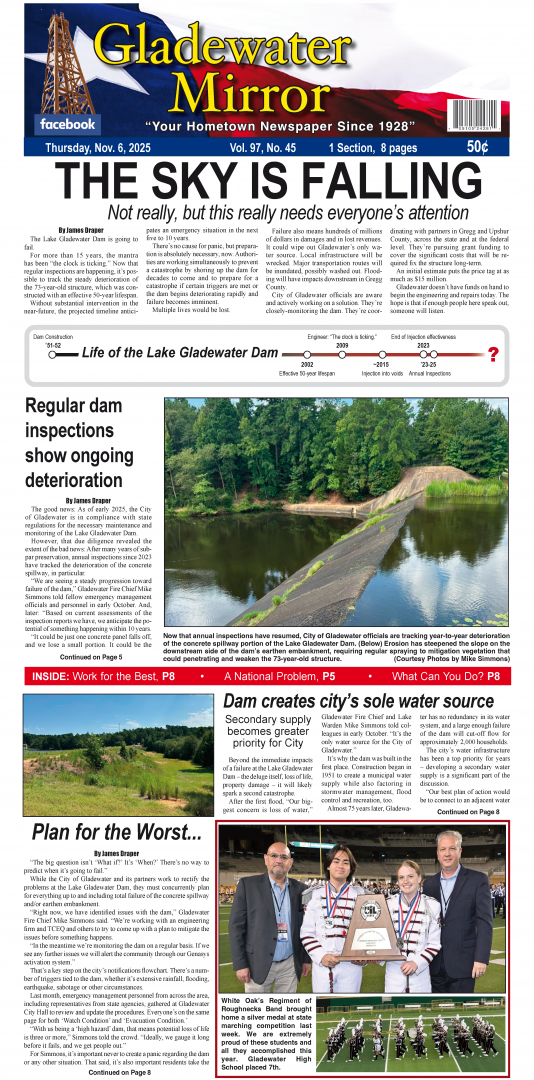This is the FOURTH in a series of stories focused on the Lake Gladewater Dam and published in the Nov. 6 issue of the Gladewater Mirror |
Part 1: The Sky is Falling
Part 2: Regular dam inspections show ongoing deterioration
Part 3: Gladewater dam creates community’s sole water source
Part 4: Plan for the Worst…
Part 5: …Work for the Best
Part 6: What can you do?
Part 7: Aging dams become common problem for U.S. communities
Add’l: Lake Gladewater Dam (Landscape Ecology assessment by E. Simpson, Aug. 2, 2024)
“The big question isn’t ‘What if?’ It’s ‘When?’ There’s no way to predict when it’s going to fail.”
While the City of Gladewater and its partners work to rectify the problems at the Lake Gladewater Dam, they must concurrently plan for everything up to and including total failure of the concrete spillway and/or earthen embankment.
“Right now, we have identified issues with the dam,” Gladewater Fire Chief Mike Simmons said. “We’re working with an engineering firm and TCEQ and others to try to come up with a plan to mitigate the issues before something happens.
“In the meantime we’re monitoring the dam on a regular basis. If we see any further issues we will alert the community through our Genasys activation system.”
That’s a key step on the city’s notifications flowchart. There’s a number of triggers tied to the dam, whether it’s extensive rainfall, flooding, earthquake, sabotage or other circumstances.
Last month, emergency management personnel from across the area, including representatives from state agencies, gathered at Gladewater City Hall to review and update the procedures. Everyone’s on the same page for both ‘Watch Condition’ and ‘Evacuation Condition.’
“With us being a ‘high hazard’ dam, that means potential loss of life is three or more,” Simmons told the crowd. “Ideally, we gauge it long before it fails, and we get people out.”
For Simmons, it’s important never to create a panic regarding the dam or any other situation. That said, it’s also important residents take the potential threat seriously, that they have a plan in place for their safety now and pay attention to any alerts that come along.
In the event of a major failure, the city’s Emergency Action Plan factors in everything from moving people out of harm’s way to bringing bottled water in when streets are compromised.
Based on updated flood maps if the dam fails, “Major roads and railways will probably be shut down,” Simmons reminded his colleagues. “Our city will be essentially shut down. It’s going to affect our ability to provide emergency operations.”
The deluge will overwhelm water/sewer infrastructure. The lake could likely drain below the water plant’s intake.
“Schools are obviously going to be affected. Our nursing homes are going to be affected. Businesses are going to be affected,” Simmons said, with between 75 and 100 buildings, commercial and residential, in the flood path in addition to the Union Pacific railroad tracks. “The airport is going to be shut down because half that runway is going to be underwater.
“If you think about the economic impact of the failure of this high hazard dam… The city’s going to be cut in half.”
And for how long? Repairs will take months or years depending on the severity.
“They tell you, try to fix it before it happens. We’re talking a $14-15 million dollar repair versus hundreds of millions on the backside.”
And Gladewater’s cost is a drop in the bucket, with tens of thousands of similar high-value projects seeking the same public dollars. The reality is, there’s plenty of mitigation funding available after a disaster, significantly less to prevent one.
“That’s what the high hazard mitigation funds are for, to target pre-disaster,” Simmons said, and the City of Gladewater is pursuing those monies. “We’re in a better place now where council has a better understanding of it, city officials have a better understanding.
“We’re doing our due diligence.”
– By JAMES DRAPER









